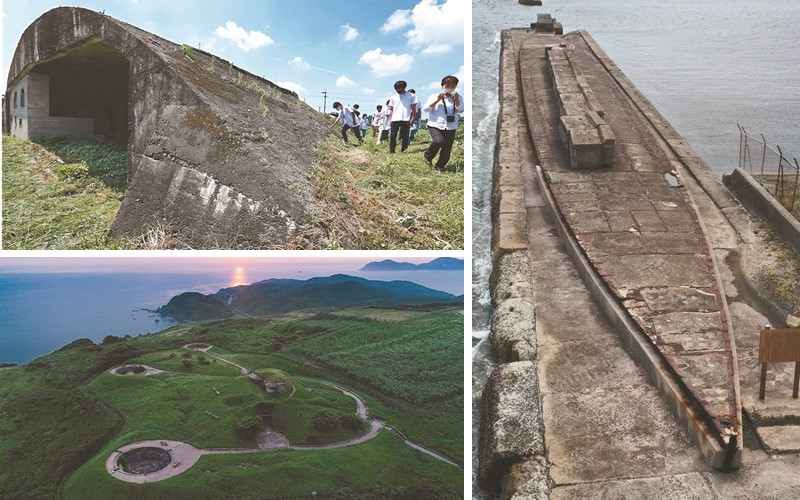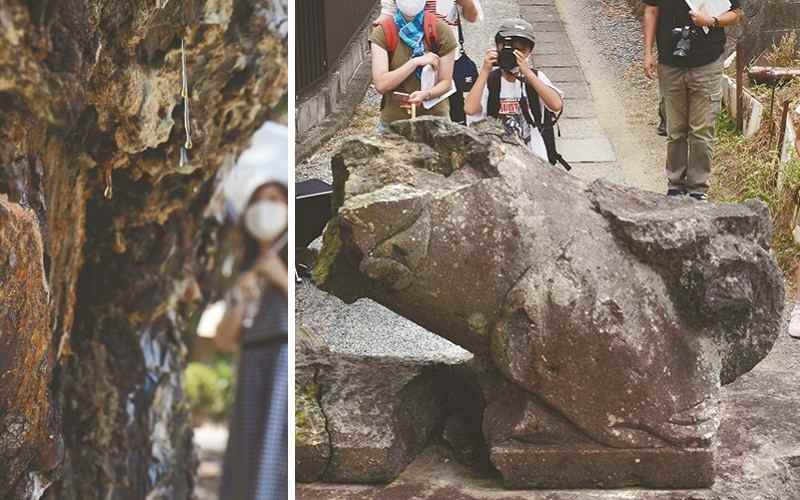
Right:
A breakwater in Hibikinada uses a decommissioned destroyer in Kitakyushu.
Three years after the end of the war, three destroyers were placed at the entrance to Dokai Bay,
but the only remaining destroyer, Yanagi, is deteriorating.
Left Top:
The hangar at the Tachiarai North Airfield in Chikuzen, Fukuoka Prefecture.
There were 40 to 50 of these hangars in the area, but this is the only one that still exists.
Left Down:
The gun emplacements of the Oshima gun batteries
in Munakata, Fukuoka Prefecture, are seen under the morning sun.
Four cannons were placed there in 1936.
An observation post and ammunition storage hut still remain.
16:47 JST, September 26, 2021
With 76 years having passed since the end of World War II, the number of people who are able to offer personal accounts of their experiences during the war is decreasing. Because of this, there is growing interest in “wartime ruins” to serve as silent storytellers.
The Fukuoka Prefectural Board of Education in 2017 began to better grasp the war ruins, the full extent of which had been largely unknown. The board managed to identify 624 wartime ruins and 1,025 monuments of consolation and loyalty by making inquiries to the Kyushu Historical Museum in Ogori, Fukuoka Prefecture, local governments and other organizations, examining historical documents and conducting field surveys over three years.
A report on a survey covering all of the 1,649 war sites in Fukuoka Prefecture was published in 2020, and 700 copies, including additional printings, sold out. The contents were eventually digitized and made available on the prefecture’s website.
Seinan Gakuin University professor Shinji Ito, who served as a member of the wartime ruins research committee for the project, defines these remnants of war as public cultural assets that dot the landscape of daily life and can be used to pass on memories of the conflict.
Because their academic value is not yet established, many of them have been damaged over time amid land development projects and deterioration, and many are now in danger of being completely lost.
Ito made the following recommendations: “It is essential and of the highest priority to place them proactively within the framework of administration of cultural properties. These remnants should be used as cornerstones for maintaining a society that will not repeat war.”

Right:
A Bishamonten koma dog, the upper half of which was blown off in an air raid, remains at a shrine in Omuta, Fukuoka Prefecture, that was struck five times between November 1944 and August 1945.
Left:
A pine tree at Seinan Gakuin University in Fukuoka city.
There are at least 10 pine trees on campus that have been damaged by people.
Pine tar, harvested at the end of the war as alternative fuel for military aircraft, is still dripping.
"Society" POPULAR ARTICLE
-

M4.9 Earthquake Hits Tokyo, Neighboring Prefectures
-

Israeli Tourists Refused Accommodation at Hotel in Japan’s Nagano Pref., Prompting Protest by Israeli Embassy and Probe by Prefecture
-

M7.5 Earthquake Hits Northern Japan; Tsunami Waves Observed in Hokkaido, Aomori and Iwate Prefectures
-

Tsukiji Market Urges Tourists to Avoid Visiting in Year-End
-

High School in Kyoto Says Students Shoplifted during Recent School Trip to Bali, Indonesia
JN ACCESS RANKING
-

Tokyo Economic Security Forum to Hold Inaugural Meeting Amid Tense Global Environment
-

Keidanren Chairman Yoshinobu Tsutsui Visits Kashiwazaki-Kariwa Nuclear Power Plant; Inspects New Emergency Safety System
-

Imports of Rare Earths from China Facing Delays, May Be Caused by Deterioration of Japan-China Relations
-

University of Tokyo Professor Discusses Japanese Economic Security in Interview Ahead of Forum
-

Japan Pulls out of Vietnam Nuclear Project, Complicating Hanoi’s Power Plans
























